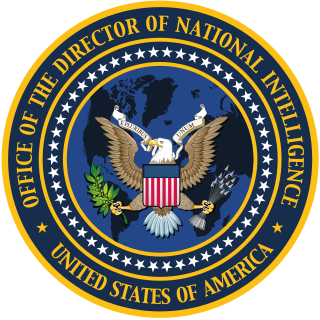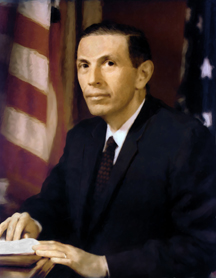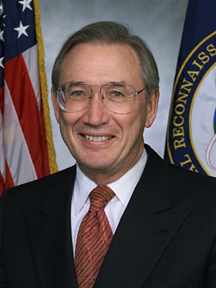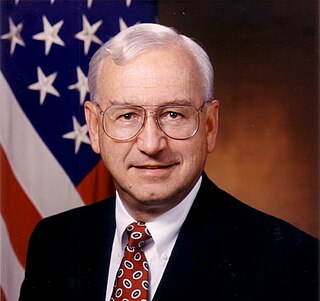
The CORONA program was a series of American strategic reconnaissance satellites produced and operated by the Central Intelligence Agency (CIA) Directorate of Science &Technology with substantial assistance from the U.S. Air Force. The CORONA satellites were used for photographic surveillance of the Soviet Union (USSR),China,and other areas beginning in June 1959 and ending in May 1972.

The National Geospatial-Intelligence Agency (NGA) is a combat support agency within the United States Department of Defense whose primary mission is collecting,analyzing,and distributing geospatial intelligence (GEOINT) in support of national security. Initially known as the National Imagery and Mapping Agency (NIMA) from 1996 to 2003,it is a member of the United States Intelligence Community.

The National Reconnaissance Office (NRO) is a member of the United States Intelligence Community and an agency of the United States Department of Defense which designs,builds,launches,and operates the reconnaissance satellites of the U.S. federal government. It provides satellite intelligence to several government agencies,particularly signals intelligence (SIGINT) to the National Security Agency (NSA),imagery intelligence (IMINT) to the National Geospatial-Intelligence Agency (NGA),and measurement and signature intelligence (MASINT) to the Defense Intelligence Agency (DIA). The NRO announced in 2023 that it plans within the following decade to quadruple the number of satellites it operates and increase the number of signals and images it delivers by a factor of ten.

The director of national intelligence (DNI) is a senior cabinet-level United States government official,required by the Intelligence Reform and Terrorism Prevention Act of 2004 to serve as executive head of the United States Intelligence Community (IC) and to direct and oversee the National Intelligence Program (NIP). All 18 IC agencies,including the Central Intelligence Agency (CIA),the Defense Intelligence Agency (DIA) and the National Security Agency (NSA),report directly to the DNI.
The Aerospace Corporation is an American nonprofit corporation that operates a federally funded research and development center (FFRDC). The corporation provides technical guidance and advice on all aspects of space missions to military,civil,and commercial customers. As the FFRDC for national-security space,Aerospace works closely with organizations such as the United States Space Force (USSF) and the National Reconnaissance Office (NRO) to provide "objective technical analyses and assessments for space programs that serve the national interest". Although the USSF and NRO are primary customers,Aerospace performs work for civil agencies such as NASA and NOAA as well as international organizations and governments in the national interest. Aerospace,as part of its charter,also provides expertise to commercial entities,both established companies and startups,domestically and abroad.

The under secretary of defense for intelligence and security or USD(I&S) is a high-ranking civilian position in the Office of the Secretary of Defense (OSD) within the U.S. Department of Defense (DoD) that acts as the principal civilian advisor and deputy to the secretary of defense (SecDef) and deputy secretary of defense (DepSecDef) on matters relating to military intelligence and security. The under secretary is appointed as a civilian by the president and confirmed by the Senate to serve at the pleasure of the president.

Lieutenant General Lincoln D. Faurer was United States Air Force officer who served as director of the National Security Agency and chief of the Central Security Service from 1981 to 1985.

Scott F. Large is an American intelligence officer who served as the sixteenth Director of the National Reconnaissance Office from 2007 to 2009. He previously served as the Principal Deputy Director of the National Reconnaissance Office from April to October 2007,and as the Central Intelligence Agency's Associate Deputy Director for Science and Technology.

Keith Ralph Hall is a United States government official who served as the 12th director of the National Reconnaissance Office (NRO).

Martin Clark Faga was the tenth director of the National Reconnaissance Office (DNRO).

Alexander Henry Flax was the Chief Scientist of the U.S. Air Force (USAF) from 1959 to 1961,Assistant Secretary of the Air Force for Research and Development from 1963 to 1969,and the third Director of the National Reconnaissance Office (NRO) from 1965 to 1969. He was the director at a time when the second generation of imaging systems became operational and began to play a major role in United States intelligence during the Cold War. He oversaw major growth in NRO funding and personnel,the development of signals intelligence collectors from space,and the development of electro-optical imaging for US reconnaissance satellites.

Betty Jean Sapp is the former Director of the National Reconnaissance Office (DNRO). She served as a United States Air Force Officer in a variety of roles,before joining the Central Intelligence Agency in 1997. She was the first female Director of the NRO,serving nearly seven years.

Dennis D. Fitzgerald was the first Principal Deputy Director of the National Reconnaissance Office
Carl Ernest Duckett was an American intelligence officer known for being the founder of the Central Intelligence Agency's science and technology operations.

Paul Garrett Kaminski is a technologist and former U.S. government official,best known for his leading role in the development of stealth aircraft.

Sentient is a heavily classified artificial intelligence satellite intelligence analysis system of the United States Intelligence Community,operated by the National Reconnaissance Office (NRO) and developed by their Advanced Systems and Technology Directorate (AS&T),with the United States Air Forces Research Laboratory at Wright-Patterson Air Force Base and the Department of Energy's National Laboratories.

Donna D. Shipton is a United States Air Force lieutenant general who serves as commander of the Air Force Life Cycle Management Center. The center is responsible for total life cycle management for aircraft,engines,munitions,electronic,computer,network,cyber and agile combat support systems. The center employs more than 28,000 people and has a budget of over $300 billion. Previously she served as military deputy to the Assistant Secretary of the Air Force for Acquisition,Technology and Logistics.

Christopher Stephen Povak is a United States Space Force major general who serves as the deputy director of the National Reconnaissance Office and commander of the Space Force Element to the National Reconnaissance Office. He previously served as the deputy director of the Space Warfighting Analysis Center.

Donald Jason Cothern is a United States Space Force major general who serves as the program executive for ground-based weapon systems at the Missile Defense Agency. He previously served as the deputy commander of the Space Systems Command. He transferred to the Space Force from the United States Air Force in May 2021.

Michael Anthony Guetlein is a United States Space Force general who serves as the second vice chief of space operations. He recently served as the first commander of Space Systems Command from 2021 to 2024. He previously served as the deputy director of the National Reconnaissance Office from 2019 to 2021.


















